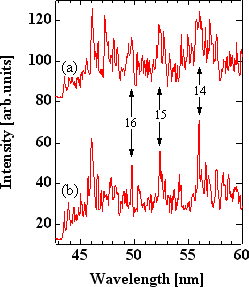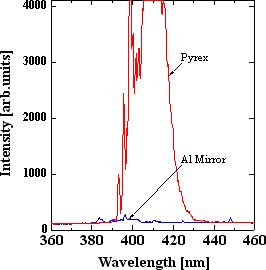Physical Science Laboratory
Coherent soft x-ray sources are indispensable tools for the development of novel technologies related to generation and control of attosecond pulses and nanometer resolution observation. Accordingly, many institutions throughout the world are now working energetically for their realization, using various schemes such as x-ray lasers and high-order harmonic generation. In the present work, we investigate a novel method called solid surface harmonic generation, and try to achieve breakthrough in this field using targets with novel characteristics and surface structures.
First we observed the surface harmonics spectrum in the extreme ultraviolet (XUV) region. The pump laser is a terawatt Ti:sapphire laser (55 fs pulse width, 4×1016 W cm-2 peak intensity, P-polarized), and is focused onto silicon wafer targets at an incidence angle of 45o using off-axis paraboloid. Fig.1 shows the time-integrated XUV spectrum observed in the specular direction of reflection. (a) is the spectrum observed for pump laser with a smooth spectral profile, while (b) is for that observed using pump laser with a similar spectrum but with an additional narrow spectral component. High-order harmonics corresponding to the 14th through 16th order of the 790 nm wavelength fundamental is clearly observed. The narrow spectral component of the fundamental is also reflected in the harmonics shown in (b), which indicates that these spectra are actually harmonics.
We have also observed a new phenomenon, where the second-order harmonic intensity drastically increases for certain target material. Fig.2 shows the integrated second harmonic intensity observed using Pyrex glass and aluminum deposited targets, both with a surface flatness of λ/4. Surprisingly, the second harmonic intensity from Pyrex targets are more than two-orders of magnitude larger than that observed using aluminum mirror. The second harmonic intensity tends to show large shot-to-shot variation with Pyrex targets, and disappears completely when using S-polarized pump lasers. We presently attribute this phenomenon to the effects of preplasma scalelength produced on the target surface by prepulse or pedestal.
 |
 |
||||
|
|